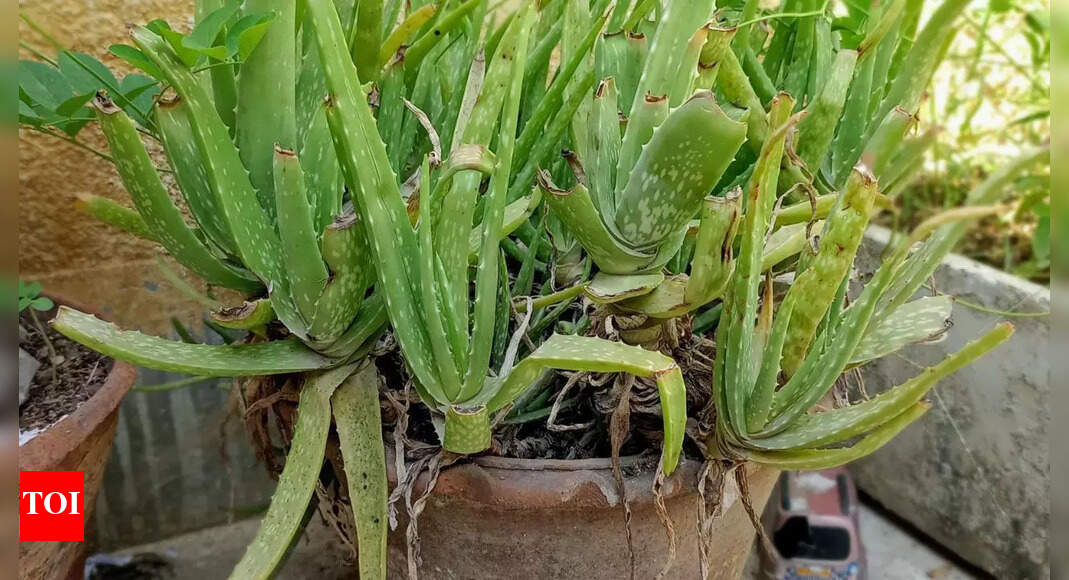6 common mistakes that are slowly killing your aloe vera plant and how to fix them | – Times of India

Wondering why your aloe vera plant looks unhealthy despite your best efforts? Aloe vera is known for being hardy, but even this tough succulent can suffer from improper care. Yellowing leaves, mushy roots, or curling tips are all signs of distress, and they usually stem from a few common mistakes. Fortunately, most of these issues are easy to fix with a few simple changes. In this guide, we’ll uncover the most common aloe vera care mistakes and show you how to bring your plant back to vibrant, healthy life.
Why your aloe vera plant is dying and how to save it
Overwatering
One of the biggest mistakes with aloe vera is giving it more water than it needs. Aloe stores water in its thick, fleshy leaves, which makes it highly drought-tolerant. When you water too frequently or let the soil stay wet for long periods, the roots can rot due to lack of oxygen. This often shows up as yellow, mushy, or collapsing leaves. To prevent this, only water your aloe vera when the top 2–3 inches of soil feel completely dry. Always use a pot with drainage holes and never let the plant sit in a tray of standing water. In cooler months, reduce watering further, as the plant’s water needs decrease.
Poor Drainage
Even if you’re not watering too much, using the wrong soil or pot can still lead to root rot. Aloe vera needs soil that drains quickly—dense or compacted soil holds too much moisture and suffocates the roots. For best results, plant your aloe in a cactus or succulent soil mix. You can also improve aeration by adding coarse sand, pumice, or perlite. Use a terracotta or unglazed ceramic pot, which allows excess moisture to evaporate faster.
Insufficient Light
Aloe vera loves sunlight. If it’s kept in low-light areas or away from windows, it will become pale, yellow, or grow leggy and weak as it stretches towards any light source. Lack of light weakens its overall health. To support healthy growth, place your aloe vera near a bright window where it can get 6–8 hours of indirect sunlight daily. East or south-facing windows are ideal. Rotate the pot regularly to ensure even exposure and prevent leaning.
Sudden Changes in Environment
Aloe vera doesn’t respond well to abrupt shifts in its environment. Moving it suddenly from shade to full sun can result in sunburned leaves. Likewise, putting it near air conditioning, heating vents, or drafty windows can cause stress. When relocating the plant, do it gradually, allowing it to adjust over several days. Also, avoid placing it near cold drafts, heat blasts, or areas where the temperature fluctuates frequently.
Nutrient Deficiency
While aloe vera is a light feeder, it still needs some nutrients to grow healthily, especially if it’s been in the same pot for a long time. A lack of key nutrients like nitrogen, potassium, or iron can result in slow growth and pale yellow leaves. Feeding your aloe once or twice a year with a diluted, balanced liquid fertiliser in spring or early summer is usually sufficient. Avoid fertilising in winter, and be cautious not to overdo it, as excess fertiliser can damage the roots.
Cold Exposure
Aloe vera is a warm-climate plant and doesn’t tolerate cold well. Temperatures below 10°C (50°F) can harm the plant and lead to brown or yellow leaves, especially if combined with overwatering. During winter or in colder climates, move your plant indoors and place it in a warm, draft-free location. Keep it away from cold windows and heating vents to avoid sudden temperature stress.It’s completely normal for the older, bottom leaves of an aloe vera plant to turn yellow and die off. This is part of its natural growth cycle. Just trim away the dead or dying leaves with clean scissors and focus on giving your plant consistent, gentle care. With just a few adjustments, you can revive even the saddest-looking aloe vera and help it thrive again, green, plump, and full of life.Also Read: How to remove and prevent algae on tiles and concrete during the rainy season
var _mfq = window._mfq || [];
_mfq.push([“setVariable”, “toi_titan”, window.location.href]);
!(function(f, b, e, v, n, t, s) {
function loadFBEvents(isFBCampaignActive) {
if (!isFBCampaignActive) {
return;
}
(function(f, b, e, v, n, t, s) {
if (f.fbq) return;
n = f.fbq = function() {
n.callMethod ? n.callMethod(…arguments) : n.queue.push(arguments);
};
if (!f._fbq) f._fbq = n;
n.push = n;
n.loaded = !0;
n.version = ‘2.0’;
n.queue = [];
t = b.createElement(e);
t.async = !0;
t.defer = !0;
t.src = v;
s = b.getElementsByTagName(e)[0];
s.parentNode.insertBefore(t, s);
})(f, b, e, ‘https://connect.facebook.net/en_US/fbevents.js’, n, t, s);
fbq(‘init’, ‘593671331875494’);
fbq(‘track’, ‘PageView’);
};
function loadGtagEvents(isGoogleCampaignActive) {
if (!isGoogleCampaignActive) {
return;
}
var id = document.getElementById(‘toi-plus-google-campaign’);
if (id) {
return;
}
(function(f, b, e, v, n, t, s) {
t = b.createElement(e);
t.async = !0;
t.defer = !0;
t.src = v;
t.id = ‘toi-plus-google-campaign’;
s = b.getElementsByTagName(e)[0];
s.parentNode.insertBefore(t, s);
})(f, b, e, ‘https://www.googletagmanager.com/gtag/js?id=AW-877820074’, n, t, s);
};
function loadSurvicateJs(allowedSurvicateSections = []){
const section = window.location.pathname.split(‘/’)[1]
const isHomePageAllowed = window.location.pathname === ‘/’ && allowedSurvicateSections.includes(‘homepage’)
const ifAllowedOnAllPages = allowedSurvicateSections && allowedSurvicateSections.includes(‘all’);
if(allowedSurvicateSections.includes(section) || isHomePageAllowed || ifAllowedOnAllPages){
(function(w) {
function setAttributes() {
var prime_user_status = window.isPrime ? ‘paid’ : ‘free’ ;
var geoLocation = window?.geoinfo?.CountryCode ? window?.geoinfo?.CountryCode : ‘IN’ ;
w._sva.setVisitorTraits({
toi_user_subscription_status : prime_user_status,
toi_user_geolocation : geoLocation
});
}
if (w._sva && w._sva.setVisitorTraits) {
setAttributes();
} else {
w.addEventListener(“SurvicateReady”, setAttributes);
}
var s = document.createElement(‘script’);
s.src=”https://survey.survicate.com/workspaces/0be6ae9845d14a7c8ff08a7a00bd9b21/web_surveys.js”;
s.async = true;
var e = document.getElementsByTagName(‘script’)[0];
e.parentNode.insertBefore(s, e);
})(window);
}
}
window.TimesApps = window.TimesApps || {};
var TimesApps = window.TimesApps;
TimesApps.toiPlusEvents = function(config) {
var isConfigAvailable = “toiplus_site_settings” in f && “isFBCampaignActive” in f.toiplus_site_settings && “isGoogleCampaignActive” in f.toiplus_site_settings;
var isPrimeUser = window.isPrime;
var isPrimeUserLayout = window.isPrimeUserLayout;
if (isConfigAvailable && !isPrimeUser) {
loadGtagEvents(f.toiplus_site_settings.isGoogleCampaignActive);
loadFBEvents(f.toiplus_site_settings.isFBCampaignActive);
loadSurvicateJs(f.toiplus_site_settings.allowedSurvicateSections);
} else {
var JarvisUrl=”https://jarvis.indiatimes.com/v1/feeds/toi_plus/site_settings/643526e21443833f0c454615?db_env=published”;
window.getFromClient(JarvisUrl, function(config){
if (config) {
const allowedSectionSuricate = (isPrimeUserLayout) ? config?.allowedSurvicatePrimeSections : config?.allowedSurvicateSections
loadGtagEvents(config?.isGoogleCampaignActive);
loadFBEvents(config?.isFBCampaignActive);
loadSurvicateJs(allowedSectionSuricate);
}
})
}
};
})(
window,
document,
‘script’,
);
[title_words_as_hashtags



